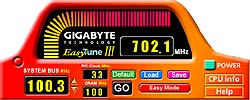OVERCLOCKING:
Speaking of EasyTune III, lets explore the overclockability of this funky
blue PCB motherboard with apparently everything you could ever need already
integrated. Overclocking of the socket 370 CPU is accomplished not from the
BIOS, as is the case with many motherboards, but instead from Windows, and
EasyTune III.
|

|
| Simple overclocking for the newbie, restrictive
overclocking for the experienced user highlight our opinion of Easy
TuneIII. While the automatic overclocking is a neat feature to use, it
takes no heed of active cooling which may enable higher values. A minor
88Mhz highlight Easy Tune's attempt at overclocking our 700E. |
|

|
| The advanced mode of EasyTune gives you
better control over FSB settings but absolutly no influence over
Vcore. The display is a nice feature, and with a good copper heatsink
(Frosty CopperPins) we were able to achieve a stable 840Mhz,
by no means near the limits of what our 700E should be able to
do. |
My personal preference is tweaking through the BIOS, for several reasons. One
you get control over the voltage going to the CPU, and two, there are generally
more options as far as FSB speeds go.... for instance the Abit BF6 has FSB
speeds in increments of 1 all the way up to 200 FSB.
EasyTune III has two main settings, one for automatically overclocking, and the
other allows more control over the individual settings. The "Auto Optimize"
button does a system analysis, checks possible settings and then overclocks. In
our case this equates to a PIII Cumine 700E being pumped up a lowly 88Mhz, to
sit at 788Mhz. The progie lets you select the default setting with one click,
which is what we did before heading on over to the advanced options.
In the advanced mode you gain direct control over the Front Side
Bus in increments of 100, 103, 112.5, 115, 120, 125, 128 and 130FSB. This is quite
restrictive I find. I prefer having the ability to go all
the way up to 150FSB at the very least. The program displays the system bus, PCI
clock, and DRAM MHZ as well as the final overclocked speed
up above.
There are
no options to change Vcore, but there is a jumper on the board
which will increase "CPU voltage" 10%. GigaByte calls this little jumper "Magic Booster." Finally, for
different users, settings can be saved and loaded up to suite personal
overclocking tastes.
I find this way of overclocking a bit strange, but for first time
overclockers this is going to give them the tools to do what they may have never
done before.
